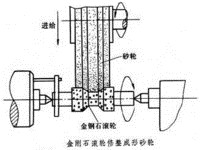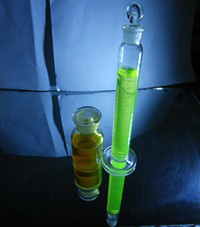

The degree of clogging of different grinding wheels is very different. From the perspective of reducing the degree of clogging and improving the grinding effect, different types of abrasives should be used for different workpiece materials. If the selected abrasive cannot adapt to the grinding performance of the workpiece material, it will easily cause a sharp blockage and make the processing unable to proceed normally.
The particle size of the abrasive has a certain effect on the blockage of the grinding wheel. Generally, fine particle size is more likely to cause clogging than coarse particle size. Comparing with #60 grinding wheel and #100 grinding wheel, under the same conditions, the latter has a large amount of blockage. However, as the number of cuts increases, the cutting depth of the coarse-grained grinding wheel is larger than that of the fine-grained grinding wheel, the abrasive cutting edge wear is greater, and the grinding temperature rises, and the chip fusion in the pores increases. After a certain number of times, the clogging amount of the coarse-grained grinding wheel will exceed the clogging amount of the fine-grained grinding wheel.
The hardness of the grinding wheel has a greater influence on the amount of clogging. Generally speaking, the harder the grinding wheel, the greater the amount of clogging.
The denser the structure of the grinding wheel, the more the number of abrasive particles that work, the shorter the distance between the cutting edges, and the easier it is to block. Grinding wheels with 45% abrasive grains have half the average clogging capacity of 49.2% abrasives; wheels with 53% abrasive grains have twice the average clogging capacity of 49.2% abrasives. When grinding difficult-to-process materials that are prone to clogging, the effect of grinding with large holes is generally better.
The main functions of the pores of the grinding wheel are chip holding and cooling. Generally speaking, a grinding wheel with more porosity and larger pores is less likely to be blocked than a grinding wheel with fewer pores and small pores.
The influence of the linear speed of the grinding wheel is more complicated. When the grinding wheel is increased from 28.8m/s to 33.6m/s, the speed increases by 16%, and the blockage increases three times. Because the increase of the grinding wheel linear speed reduces the maximum cutting depth of the abrasive particles, the chip cross-sectional area decreases, and the number of cuts and the grinding heat increase at the same time, these two factors can increase the amount of clogging, but when the grinding wheel linear speed reaches a certain level When (for example, up to 50m/s or more), the blockage of the grinding wheel is greatly reduced.
The influence of the linear speed of the grinding wheel is more complicated. When the grinding wheel is increased from 28.8m/s to 33.6m/s, the speed increases by 16%, and the blockage increases three times. Because the increase of the grinding wheel linear speed reduces the maximum cutting depth of the abrasive particles, the chip cross-sectional area decreases, and the number of cuts and the grinding heat increase at the same time, these two factors can increase the amount of clogging, but when the grinding wheel linear speed reaches a certain level When (for example, up to 50m/s or more), the blockage of the grinding wheel is greatly reduced.
The influence of the radial cutting amount on the blockage of the grinding wheel shows a hump trend. When the radial cutting amount is small, (ap <0.01mm) clogging occurs. As the cutting amount increases, the average blockage amount also increases. When the cutting amount increases to at a certain level (ap = 0.03mm), the amount of clogging shows a decreasing trend, and then as the cutting amount continues to increase (up to ap = 0.04mm), the amount of clogging rises sharply.
Generally, under the same total amount of grinding, the slower the axial feed rate, the more times the abrasive grains grind the workpiece, so the temperature of the ground surface is higher, and the amount of blockage increases. For example, when the axial feed speed is reduced from 1.2m/min to 0.5m/min, the blockage of the grinding wheel will increase by 5 times. Under the condition of 0.5m/min, fine chips are produced, most of which are embedded in the pores; when the axial speed is 1.2m/min, long chips are produced, which are only embedded in the pores.

When the dressing speed of the grinding wheel is low, the working surface of the grinding wheel is flat, and the number of effective sharpening edges per unit area increases, so that the cross-sectional area of the chips becomes smaller, and the number of chips increases, so it is easy to cause blockage. When the dressing speed of the grinding wheel is high, the working surface of the grinding wheel becomes thicker, and the number of effective abrasive particles decreases. There are recesses on the surface of the grinding wheel, which play the role of pores. The chips are easily washed away and the sintered material is easy to fall off. Therefore, various grinding wheels have an optimal speed range when dressing.
The effect of workpiece speed on the degree of blockage of the grinding wheel is closely related to other factors in the cutting conditions. Under the given experimental conditions, the rotation speed of the workpiece is doubled, and the blockage of the grinding wheel is tripled. This is because the higher the workpiece speed, the shallower the penetration depth of the abrasive grains, and the smaller the chip cross-sectional area, which is equivalent to the hardening of the grinding wheel, so it is easy to cause the grinding wheel to block.
Different grinding fluids have a great influence on the grinding effect. The general water-based grinding fluid contains a lot of mineral oil and oily additives. After dilution, it becomes an oil-in-water milky white liquid. Its specific heat capacity and thermal conductivity are small. It is in the process of violent friction. It is easy to cause adhesive wear and diffuse wear between the grinding wheel and the workpiece, block the grinding wheel, increase the grinding force, and finally cause premature crushing and shedding of abrasive particles, which reduces the grinding ratio. Therefore, generally difficult-to-machine materials should choose grinding fluid with better lubricity or change to grinding oil cooling to better reduce clogging.

Generally speaking, plunge grinding is more clogged than longitudinal grinding. Due to the large contact area between the grinding wheel and the workpiece during plunge grinding, the abrasive cutting edge has to be rubbed several times on the same wear mark, and it is difficult for the coolant to enter the grinding area, so the heat during grinding is high and it is easy to cause blockage conditions of. During longitudinal grinding, the first contact with the workpiece material is the side edge of the grinding wheel, the contact area is small, the coolant easily enters the grinding area, and the abrasive wear only occurs on the first side edge. When the wear surface increases to a certain extent, the abrasive grains are broken and fractured under the action of the grinding force to realize self-sharpening. Most abrasive particles can work in a sharp state, so that the grinding force and grinding heat are relatively low. At the same time, a considerable part of the zone affected by the grinding force and grinding heat can be discharged out of the workpiece along the longitudinal grinding direction, so the possibility of chemical adhesion is reduced. The combined effect of the above factors makes the degree of clogging of the grinding wheel of the longitudinal grinding lower than that of the cut-in grinding.
Semiconductor Industry Solutions
PCD & PCBN Tools Grinding Industry
Diamond Cutting Bruting Polishing
Add: No.171 Zhongyuan Rd, Zhongyuan District, Zhengzhou, 450001, Henan, China
Tel: +86-371-86545906
Phone / Whats App: +86 18339903057
E-mail: [email protected]



